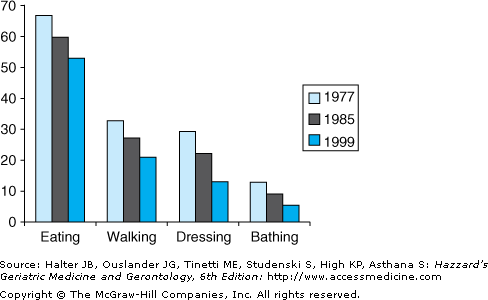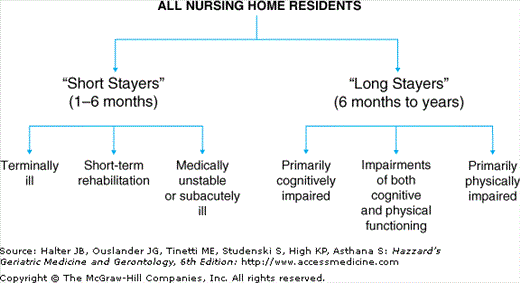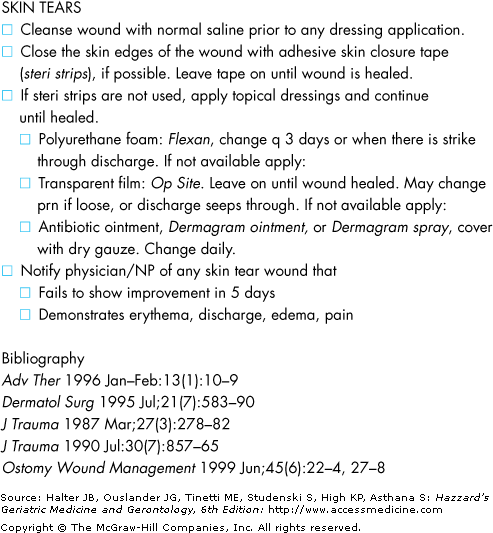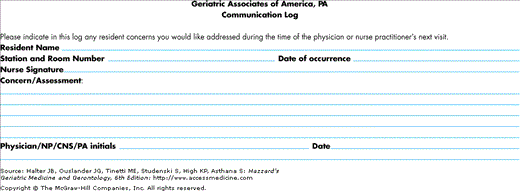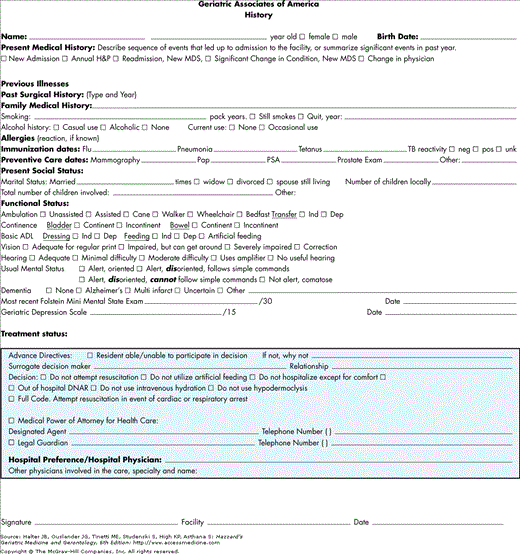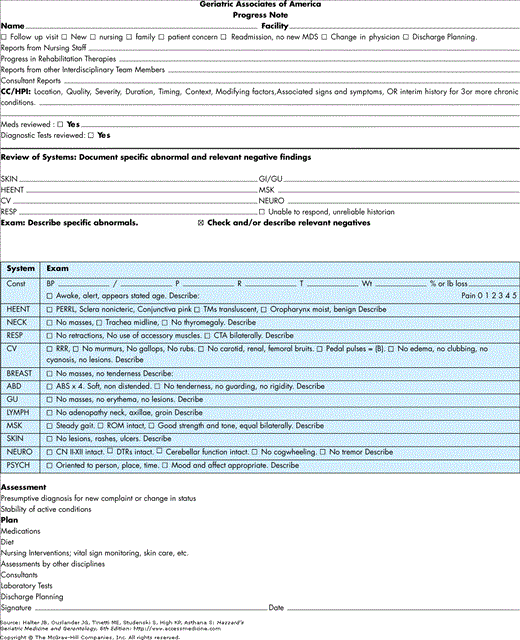Nursing Facility Care: Introduction
The current cohort of older Americans is a more robust group than in the past, and the prevalence of disability related to chronic disease is in decline. Despite improvements in the health of older people as a whole, the overall need for services provided by nursing facilities will rise. In the future, the medical needs of nursing facility residents will likely be more complex and require additional services from primary care practitioners, including physicians, nurse practitioners, clinical nurse specialists, and physician assistants. Nursing facilities already show a trend in the increasing percentage of residents who are not able to perform activities such as dressing and bathing independently. As shown in Figure 21-1, over a 20-year span, residents able to feed themselves declined from 67% to 53% and those able to dress themselves, from 30% to 13%.
The term nursing facility is inclusive of other commonly used terms, e.g., nursing home, long-term care facility, subacute care unit, or nursing home care unit. Nursing facilities are primarily free-standing in the community or are separate units in hospitals. Patients are usually referred to as residents. On the average, nursing facility residents have a median age of 85, three or more functional impairments, and six chronic illnesses. One-half are cognitively impaired with additional functional impairments and/or chronic illnesses. Most lack sufficient personal and financial support to remain in their homes. Payment for services rendered comes from Medicare Part A, Medicare Part B, Medicaid, Veterans Affairs, private insurance plans including long-term care insurance, and out-of pocket. Skilled nursing facilities (SNF) are subsets of nursing facilities that receive payment for skilled nursing services under Medicare Part A. SNF services include rehabilitation therapies and/or skilled nursing care, such as intravenous therapy, wound care treatment for deep pressure ulcers, or close-monitoring posthospitalization in medically complex residents.
As shown in Figure 21-2, two populations are distinguished by length of stay and goals. Long-term residents stay more than 6 months and are either cognitively impaired, physically disabled, or both. Short-stay residents of less than 3 months duration are recovering from an acute illness, suffering from a terminal illness, or are medically unstable with a limited life expectancy. From 1985 to 2001, when payment structures for hospitalized older adults changed to encourage earlier discharges, trends in admissions demonstrate hospitals released the same percentage of residents to nursing facilities. However, in 1985, 18% of nursing facility residents admitted from hospitals were discharged to the community versus 30% in 2001. Today, more residents are being admitted for rehabilitation following surgery or acute illness and need a higher level of care for a shorter period of time.
Predictors of admission to a nursing facility include functional determinants, such as decline in strength and balance, and impairment in activities of daily living (ADL), especially in toileting, dressing, and eating. Medical conditions that contribute to functional decline include stroke, diabetes mellitus, and Parkinson’s disease. For those older than 75 years of age, a decline in cognition is a consistent risk factor. Adequate caregiver support, both informal and formal, explains why many functionally dependent older adults are able to remain in community settings.
The purpose of this chapter is to help physicians, nurse practitioners, clinical nurse specialists, and physician assistants (hereafter practitioners) understand the nursing facility environment and principles of geriatric care adaptable to this special population. Regulatory issues that influence care processes, the role of nursing facility employees and consultants, and practical aspects of managing a nursing facility clinical practice are discussed.
Regulatory Issues
Following extensive reforms developed with the 1987 Omnibus Budget Reconciliation Act, The Centers for Medicare and Medicaid Services (CMS) began enforcing the revised nursing facility regulations. In response to consumer complaints and known problems in the quality of care, new rules, including considerable federal and state oversight, emphasized process and outcomes with less emphasis on structural components. The federal rules for facility participation in Medicare and Medicaid services (commonly referred to as “F-Tags”), together with survey guidelines, clarify regulations, and mandate-specific outcomes and processes of care. By regulation, on-site surveys are federally mandated. They are unannounced, and noncompliance is associated with potential costly fines. State departments of health conduct surveys of quality of care under federal CMS contracts every 9 to 15 months. Additional on-site surveys occur sporadically based on consumer complaints.
F-Tag 272 stipulates that within 2 weeks of admission, the nursing facility must perform a standardized comprehensive assessment on each resident. Facilities use a federally developed and state-approved Resident Assessment Instrument (RAI) to accomplish this, and the resulting data guides care planning, state inspections, and reimbursement under Medicare Part A and, where applicable, Medicaid. The facility transmits the information electronically to the state regulatory and survey agency.
The RAI consists of the Minimum Data Set (MDS) the Resident Assessment Protocols (RAP), and the RAP Trigger List. The MDS screens residents for the 18 functional problems listed in Table 21-1. Noting a functional problem triggers a more in-depth assessment by the facility interdisciplinary team guided by the appropriate RAP. An interdisciplinary plan of care based on this assessment must be completed by day 21 following admission. Each resident’s MDS and care plan are updated quarterly and completed in entirety annually and when a significant change in condition occurs. For the purpose of the MDS, a significant change in condition is defined as a persistent improvement or decline in mood, behavior, or functional status. More frequent assessments are performed when residents are admitted for SNF care under Medicare Part A. These assessments are a specific responsibility of the facility, and require minimal physician input.
Delirium |
Cognitive loss |
Visual function |
Communication |
ADL functional/rehabilitation potential |
Urinary incontinence and indwelling catheter |
Psychosocial well-being |
Mood state |
Behavior problem |
Activities |
Falls |
Nutritional status |
Feeding tubes |
Dehydration/fluid maintenance |
Dental care |
Pressure ulcers |
Psychotropic drug use |
Physical restraints |
The Center for Health Systems Research and Analysis (CHSRA), the Nursing Home Quality Initiative (NHQI), and measurement experts have identified and validated quality indicators (CHSRA) and quality measures (NHQI) from the MDS. Using a national reporting mechanism, facilities and state surveyors review combined quality indicator/quality measure reports (Table 21-2) to identify potential problems in a facility. The quality indicators/quality measures report identifies the facility’s percentile rank on the items, where this rank can be compared with a group norm. Three items are considered sentinel events warranting closer evaluation: fecal impaction, dehydration, and pressure ulcer development in residents at low risk for pressure ulcers. When surveyors find evidence of noncompliance with regulations, deficiencies are cited and scored based on how many residents were affected and whether there was harm or immediate threat to resident safety. Depending on the scope and seriousness of the deficiencies, facility sanctions range from in-service education to termination of the Medicare and Medicaid contract with significant monetary fines.
Long-Stay Residents |
Vaccinations |
Percent who were given the influenza vaccine during the flu season |
Percent who were assessed and given the pneumococcal vaccine |
Accidents |
Incidence of new fractures |
Prevalence of falls |
Behavior/emotional patterns |
Residents who have become more depressed or anxious |
Prevalence of behavioral symptoms affecting others |
All |
High risk |
Low risk |
Prevalence of symptoms of depression without antidepressant therapy |
Clinical management |
Use of nine or more different medications |
Cognitive patterns |
Incidence of cognitive impairment |
Elimination/incontinence |
Low-risk residents who lost control of the bowels or bladder |
Residents who have/had a catheter inserted and left in their bladder |
Prevalence of occasional or frequent bladder or bowel incontinence without a toileting plan |
Prevalence of fecal impaction |
Infection control |
Residents with a urinary tract infection |
Nutrition/eating |
Residents who lose too much weight |
Prevalence of tube feeding |
Prevalence of dehydration |
Pain management |
Residents who have moderate to severe pain |
Physical functioning |
Residents whose need for help with daily activities has increased |
Residents who spend most of their time in a bed or in a chair |
Residents whose ability to move in and around their room got worse |
Incidence of decline in range of motion |
Psychotropic drug use |
Prevalence of antipsychotic use in the absence of psychotic or related conditions |
All |
High risk |
Low risk |
Prevalence of antianxiety/hypnotic use |
Prevalence of hypnotic use more than two times in last week |
Quality of life |
Residents who were physically restrained |
Prevalence of little or no activity |
Skin care |
High-risk residents with pressure ulcers |
Low-risk residents with pressure ulcers |
Short-Stay Residents |
Postacute care measures |
Percent who were given the influenza vaccine during the flu season |
Percent who were assessed and given the pneumococcal vaccine |
Short-stay residents with delirium |
Short-stay residents who had moderate to severe pain |
Short-stay residents with pressure ulcers |
In 2001, the Secretary of the Health and Human Services Department convened a group of nursing facility industry stakeholders to develop a plan to further improve the quality of care in nursing facilities. This activity became the Nursing Home Quality Initiative (NHQI), which currently monitors regulation and enforcement, communication with consumers regarding quality, community-based quality improvement programs, and collaboration to enhance knowledge and resources.
The NQHI collaborates with CMS to communicate information to consumers on the Nursing Home Compare Web site (www.medicare.gov/NHCompare). This site allows consumers to compare the quality of nursing facility care based on the quality indicators and quality measures. The Nursing Home Compare listing distinguishes between short-stay postacute care residents and long-stay chronic care residents. In addition to quality data, the Web site includes basic demographic information for each facility, nursing staff hours, and survey results. This public display of quality data is intended to stimulate nursing facilities to improve health care in order to be competitive (Wunderlich and Kohler, 2001).
A prospective payment system (PPS) based on 53 Resource Utilization Groups (RUG) is now used to determine reimbursement for skilled nursing care under Medicare Part A. Specific items from the MDS contribute to the RUG and the daily rate Medicare pays. Residents hospitalized for at least 3 days during the past 30 days are eligible for a potential 100-day benefit for skilled nursing care. Managed care organizations may waive the 3-day prior hospitalization requirement. The advent of this reimbursement system has resulted in a significant increase in the number of nursing facilities providing skilled nursing services. Regulatory requirements for visits by physicians are similar to requirements for long-stay residents in nursing facilities. In reality, residents who receive skilled nursing services usually need more attention from practitioners because of medical complexity or discharge planning issues.
Nursing Facility Attending Physician
Physicians working in a nursing facility environment manage and coordinate care for residents with multiple chronic medical and functional conditions. Goals are to cure when appropriate, restore and maintain function, and offer comfort. Most nursing facility physicians maintain an active office practice, care for hospitalized patients, and visit their residents in the nursing facility. This is especially true in rural health care environments. An increasing number of physicians are choosing to practice exclusively in nursing facilities. Positive rewards for the full-time nursing facility physician include flexibility in the hours worked and the ability to positively influence medical care delivery. Many physicians find that as they increase their time commitment to the facility, they are integrated into the facility culture and the work becomes more satisfying. This is particularly true of physicians with dual roles to provide direct patient care and facility medical direction.
Physicians with a part-time nursing facility practice typically devote 2 hours or less per week to nursing facility care. Physicians’ perception of low reimbursement, excessive regulations, frequency of telephone calls from families, and extensive paperwork cause some physicians to hesitate to provide more time.
Nursing facilities often lack an organized medical staff typical of most hospitals. Although formal credentialing is usually not required, facilities often ask physicians to complete a medical staff application process to verify medical license and medical liability coverage. To encourage accountability, nursing facility administrators are required to ensure that physicians comply with the minimum standards for frequency of visits and quality of care set forth by federal and state regulations.
Which model of medical staff organization best benefits the resident and the facility is not clear. A closed medical staff comprising a few physicians practicing in a single nursing facility maybe associated with higher quality and intensity of care. One drawback is this limits choices for residents. Nursing facilities may be reluctant to limit the number of physicians on staff if the administrators perceive a potential decline in census because of a lack of physician referral resources. Data do not support the theory that facilities with a larger staff have either a higher census or better profitability. In fact, it appears that profitability is more closely linked to the quality of care, not the number of physician providers.
Providing medical care for nursing facility residents is intellectually stimulating and demands unique knowledge and practice skills. Although limited randomized controlled trials have produced adequate guidance in medical decision making, modifying the medical plan of care based on whether the resident has moderate to severe dementia, is physically frail, or has a limited life expectancy is a reasonable approach. Other considerations include the perceived quality life for the resident, the potential of any intervention to provide a positive benefit, risks, and costs. Physicians must also modify disease-specific management strategies. For example, dietary restrictions recommended for cardiovascular diseases and diabetes mellitus are not appropriate for undernourished residents suffering weight loss.
Medical care in a nursing facility requires an interdisciplinary team of social workers, nurses, physical therapist, pharmacists, and dieticians. Whether acting as the attending physician or medical director, physicians are an integral part of the interdisciplinary team and need to seek out and be receptive of input from the other disciplines.
Expectations of the attending physician are summarized in Table 21-3. According to F Tag 385, residents must be in the care of a physician who is expected to visit the resident in the facility unless specialized equipment is needed or a resident specifically requests an office visit. The physician visits and approves orders at least every 30 days for the first 90 days and then every 60 days thereafter. Qualified nurse practitioners, clinical nurse specialists, or physician assistants may substitute after the first required visit. For residents admitted under a Medicare Part A SNF benefit, the initial comprehensive assessment must be personally performed by the physician. This stipulation does not preclude these other practitioners from making a medically necessary visit prior to the physician’s initial comprehensive assessment. For residents without the SNF benefit, some states allow nurse practitioners, clinical nurse specialists, and physician assistants to substitute for all required physician visits. Regardless, medically necessary visits are allowed and are covered by Medicare (Table 21-4).
Assess new admissions within 30 days |
Authorize admission orders in a timely manner |
Contact the receiving institution or provider following transfer or discharge |
Make periodic, on-site visits
|
Ensure adequate coverage by alternate providers who will respond appropriately |
Provide appropriate evidence-based care to residents |
Provide appropriate, timely medical orders and documentation |
Follow principles of appropriate conduct |
Primary care provider visits
|
Consultation services
|
Diagnostic services
|
Therapeutic modalities
|
Visiting on a regular basis is encouraged whether it is daily, weekly, or on monthly schedules. Practice efficiency experts suggest physicians plan to see at least seven residents to make the site of service economically viable. The frequency of visits to the facility is determined by the number of residents under the care of the physician and the acuity. A physician planning well can care for 14 to 16 or more residents a day. Weekly visits permit conducting follow-up visits, attending to new problems, and seeing new admissions. When working with other practitioners who can visit weekly or more frequently, a physician may be able to deliver high-quality care with physician visits less than once a week. Facilities such as hospital-based SNF units or free-standing SNFs may warrant daily visits by practitioners. A balance between the physician and nurse practitioner or clinical nurse specialist visits assures that residents receive the benefits of both medicine and advanced practice nursing. Nurse practitioners, and particularly geriatric nurse practitioners, are well suited to manage syndromes such as falls, pressure ulcers, and weight loss as well as attend to the details of a monthly review of the plan of care. Table 21-5 clarifies approved delegation of physician tasks.
INITIAL REQUIRED VISIT* | INITIAL ORDERS | CERTIFICATION | RECERTIFICATION | SUBSEQUENT ORDERS | |
|---|---|---|---|---|---|
Skilled Nursing Facility (SNF): Medicare Part A | |||||
NP, CNS, PA employed by the facility | May not perform | May not sign | May not sign | May not sign | May sign |
NP, CNS not employed by the facility | May not perform | May not sign | May sign | May sign | May sign |
PA not employed by the facility | May not perform | May not sign | May not sign | May not sign | May sign |
Nursing Facility | |||||
NP, CNS, PA employed by the facility | May not perform | May not sign | May not sign | N/A | May sign |
NP, CNS, not employed by the facility | May not perform† | May not sign | May sign | N/A | May sign |
PA not employed by the facility | May not perform† | May not sign | May not sign | N/A | May sign |
Because of the physician’s intermittent presence, day-to-day contact is available via telephone. If allowed by state law and facility policy, standing orders or protocols maybe implemented for commonly occurring low-risk events such as skin tears (Figure 21-3). If weekly or more frequent visits are made, nurses may use nonurgent communication strategies, such as a communication manual to document follow-up concerns (Figure 21-4) and may store laboratory reports, dietary recommendations, and pharmacy reviews until the physician or other practitioner is in the building to address the issues. Structured progress notes and comprehensive assessments (Figures 21-5 and 21-6) are encouraged to ensure comprehensive data collection that is readily retrieved and meets or exceeds all regulatory requirements.
Nurse practitioners, clinical nurse specialists, and physician assistants are increasingly involved in nursing facility care. Whether employed by the nursing facility directly, a physician, or self-employed, their presence is noted in approximately 20% of facilities. Studies to date suggest that these practitioners working in concert with the primary care physician provide a higher level of care to nursing facility residents, enhance satisfaction with care, and decrease hospitalization rates while maintaining cost neutrality.
The nursing staff provides nearly all of the care provided to residents in nursing facilities. Nursing assistants receive at least 75 hours of training and must be certified within 4 months of employment. They provide the most basic resident care, including bathing, dressing, and eating assistance. Supervising the nursing assistants are the Licensed Vocational/Practical Nurses (LVN/LPN) that often serve as charge nurses and carry out physician orders as well as report changes in the resident’s condition. The 1-year education and training for LPN/LVNs generally focuses on tasks and procedures oriented to acute care with less attention to the supervisory role in the nursing facility setting. Facilities require a Registered Nurse (RN) to be on duty 8 hours daily, including weekends. The Director of Nurses (DON) manages nursing services and must be a RN. Registered nurses have an associate degree (2 years), a diploma (3 years), or a bachelor’s degree (4 years). Descriptions of the key personnel in nursing facilities are noted in Table 21-6.
TITLE | ROLE | TRAINING |
|---|---|---|
Certified Nursing Assistant | Provides most of the direct care for activities of daily living | At least 75 hours of training specific to caring for residents in a nursing facility |
Charge Nurse | Supervises nursing assistants, carries out physician orders, contacts physician in a change in condition | Charge nurses are often LVN/LPNs and may be RNs |
Director of Nursing | Coordinates and manages the nursing care | RN |
MDS Nurse | Facilitates and/or completes the comprehensive assessment, the Minimum Data Set [MDS] | By regulation, an RN must coordinate completion of the MDS Other licensed personnel may assist in completing the document |
Medicare Coordinator | Screens new admissions and assists with discharges of residents admitted to the skilled nursing facility | RN or LVN/LPN |
Inservice Coordinator | Orients new employees, helps existing employees maintain skills | RN or LVN/LPN May have a dual role in the facility |
Treatment Nurse | Administers topical medications, changes dressings, and may act as the pressure ulcer prevention coordinator | LVN/LPN, RN or RN with additional training in wound care such as a certified wound, ostomy, continence nurse |
Restorative Nurses Aide | After physical and occupational therapy will continue restorative care to maintain function, e.g. ambulation | Certified nursing assistant, often one with at least one year experience Reports to either nursing or physical therapy |
Medication Aide | Administers oral and topical medications under the supervision of an RN | In some states, certified nursing aides with additional training in medication administration, may administer medications |
Administrator | Financial manager | Bachelors Degree with post graduate certificate in Long-Term Care Administration |
Admissions Coordinator | Coordinates admission documentation with families and residents Frequently is the person families and residents ask to recommend an admitting physician | High school education or higher |
Medical Records Coordinator | Organizes the medical record, thins charts, maintains lists of due dates for key functions e.g., care plan updates, MDS assessments, physician visits | High school education or degree in medical records coordination |
Social Services | Provides medically related social services to attain or maintain the highest practicable physical, mental, and psychosocial well-being of each resident. | A facility over 120 beds must employ a full-time social worker with a bachelor’s degree in social work or human services |
Dietician | Identifies dietary needs, plans, and implements dietary programs | At a minimum a qualified dietician must be available as a consultant |
Consultant Pharmacist | Reviews the drug regimen of each resident, must report any irregularities to the attending physician, and the director of nursing, and these reports must be acted upon | Bachelors degree or higher in pharmacy |
Medical Director | Responsible for implementation of resident care policies and coordination of medical care in the facility | Licensed physician, may be certified as a medical director |
Ombudsman | Citizen advocate for the residents and family | Part of the Older Americans Act, lay persons (often volunteers) are trained to solve problems in the facility |
Few nursing facilities utilize electronic medical records. Checklists and flowcharts are most often used to document routine nursing tasks. Facility nurses document vital signs and residents’ general condition at least daily in the narrative nurse’s notes for residents admitted under Medicare Part A SNF care. For long-stay residents, narrative documentation is limited to unusual occurrences or acute events. Physicians find the nurses’ narrative notes a useful source of information. Many nursing facilities also document the resident’s condition on a monthly summary form, and these forms help to track trends and response to medications. The plan of care maybe in the medical record or in a separate notebook at the nursing station. Diagnostic test results, consultant’s reports, rehabilitation notes, social services records, and dietary consults usually remain in the chart for 1 year or more.
As physicians and practitioners monitor responses to medications and treatments, current daily documentation is found in other locations, usually on flowcharts in notebooks on medication and treatment carts. This documentation typically contains results of finger stick blood glucose testing, the frequency of as needed medications for pain or behavioral symptoms, behavioral monitoring for antipsychotic medications, monthly vital signs, monthly weights, treatments, and wound measurements. Daily or weekly blood pressures and pulses taken to monitor the response to antihypertensive medications or digitalis are found on the medication administration record. Automated blood pressure, temperature, and pulse oximetry equipment is usually located near the nurse’s station. Other supplies and equipment to make the day more efficient are listed in Table 21-7.
Stethescope |
Pocket Oto-ophthalmascope |
Cerumen spoon |
Reflex hammer |
Monofilament, 10 gram |
Personal digital assistant |
Drug reference |
Medical calculations |
Prescription pad |
Bandage scissor |
Mirror [to view heel ulcers] |
Pen |
The American Medical Directors Association (AMDA) suggests visiting long-stay residents monthly and short-stay SNF residents weekly. Physicians and practitioners could routinely plan to see one-fourth of the residents each week, allowing additional time to examine residents who have an acute change in condition, need additional follow-up from prior visits, or receive skilled nursing services. Following the same pattern for visits each month minimizes missing visits with residents. A list of residents by room number, with birth dates, the date of the last history and physical, date of the last physician visit, and a space to make comments assists in organizing the day.
Stay updated, free articles. Join our Telegram channel

Full access? Get Clinical Tree


